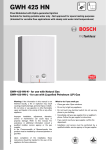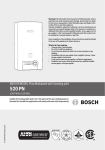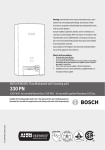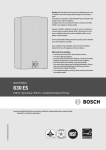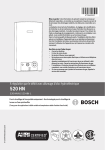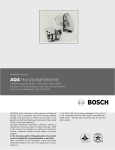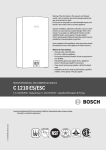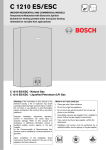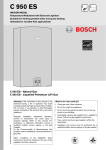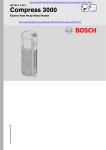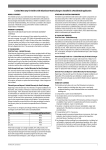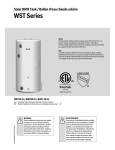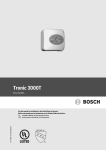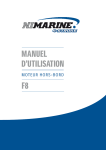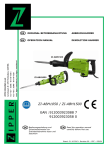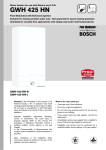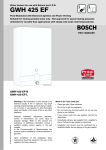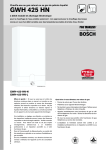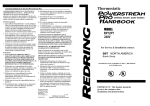Download Bosch 520-PN-L Specifications
Transcript
Warning: If the information in this manual is not followed exactly, a fire
or explosion may result causing property damage, personal injury or
death.
Do not store or use gasoline or other flammable vapor and liquids in the
vicinity of this or any other appliance.
Improper installation, adjustment, alteration, service or maintenance
can cause injury or property damage. Refer to this manual. For assistance
or additional information consult a qualified installer, service agency or
the gas supplier. In the Commonwealth of Massachusetts this product
must be installed by a licensed plumber or gas fitter.
Upon completion of the installation, these instructions should be handed
to the user of the appliance for future reference.
What to do if you smell gas
• Close gas valve. Open windows.
• Do not try to light any appliance.
• Do not touch any electrical switch; do not use any phone in your
building.
• Immediately call your gas supplier from a neighbor’s phone. Follow
the gas supplier’s instructions.
• If you cannot reach your gas supplier, call the fire department.
• Installation and service must be performed by a qualified installer,
service agency or the gas supplier.
INDOOR MODEL Flow Modulated with Hydro-generated Ignition
520 HN
520-HN-N / 520-HN -L
Suitable for heating potable water only - Not approved for space heating purposes
6 720 644 942 (2014/11) US
(Intended for variable flow applications with steady cold water inlet temperatures)
2 | Index
Index
1 Key to symbols and safety instructions . . . . . . . . . . . . 3
1.1 Key to symbols . . . . . . . . . . . . . . . . . . . . . . . . . . . . 3
1.2 General safety instructions . . . . . . . . . . . . . . . . . . . 3
2 Warning . . . . . . . . . . . . . . . . . . . . . . . . . . . . . . . . . . . . . . 6
3 Appliance details . . . . . . . . . . . . . . . . . . . . . . . . . . . . . . . 7
3.1 520 HN specifications (Technical data) . . . . . . . . 7
3.2 Unpacking the 520 HN heater . . . . . . . . . . . . . . . . 8
3.3 General rules to follow for safe operation . . . . . . . 8
3.4 Dimensions and installation clearances . . . . . . . . 10
4 Installation instructions . . . . . . . . . . . . . . . . . . . . . . . .
4.1 Introduction . . . . . . . . . . . . . . . . . . . . . . . . . . . . . .
4.2 Proper location for installing your heater . . . . . .
4.3 Mounting Heater . . . . . . . . . . . . . . . . . . . . . . . . . .
4.4 Combustion air requirements . . . . . . . . . . . . . . . .
4.5 Venting . . . . . . . . . . . . . . . . . . . . . . . . . . . . . . . . .
4.5.1Horizontal venting . . . . . . . . . . . . . . . . . . . . . . . . .
4.5.2Vertical venting . . . . . . . . . . . . . . . . . . . . . . . . . . .
4.6 Gas piping & connections . . . . . . . . . . . . . . . . . . .
4.7 Measuring gas pressure . . . . . . . . . . . . . . . . . . . .
4.8 Water connections. . . . . . . . . . . . . . . . . . . . . . . .
4.9 Recirculation application . . . . . . . . . . . . . . . . . . .
11
11
11
11
13
13
14
14
16
20
20
21
5 Operation instructions . . . . . . . . . . . . . . . . . . . . . . . . .
5.1 For your safety read before operating
your water heater . . . . . . . . . . . . . . . . . . . . . . . . .
5.2 Lighting instructions . . . . . . . . . . . . . . . . . . . . . . .
5.3 To turn off appliance . . . . . . . . . . . . . . . . . . . . . . .
5.4 Adjusting the water temperature . . . . . . . . . . . . .
5.5 Power adjustment knob . . . . . . . . . . . . . . . . . . . .
5.6 Draining the appliance . . . . . . . . . . . . . . . . . . . . .
21
21
21
22
22
23
23
6 Maintenance and service . . . . . . . . . . . . . . . . . . . . . . .
6.1 Maintenance intervals . . . . . . . . . . . . . . . . . . . . . .
6.2 Water valve . . . . . . . . . . . . . . . . . . . . . . . . . . . . . .
6.3 Pilot . . . . . . . . . . . . . . . . . . . . . . . . . . . . . . . . . . . .
6.4 Main burners . . . . . . . . . . . . . . . . . . . . . . . . . . . . .
6.5 Vent assembly / heat exchanger . . . . . . . . . . . . . .
6.6 Mineral scale build-up . . . . . . . . . . . . . . . . . . . . . .
6.6.1Descaling heat exchanger . . . . . . . . . . . . . . . . . . .
24
24
24
25
25
25
25
25
6 720 644 942 (2014/11)
7 Troubleshooting . . . . . . . . . . . . . . . . . . . . . . . . . . . . . .
7.1 Introduction . . . . . . . . . . . . . . . . . . . . . . . . . . . . . .
7.2 No spark at pilot with water flow . . . . . . . . . . . . .
7.3 Spark appears when hot water is turned on,
but pilot and burners will not ignite . . . . . . . . . . .
7.4 Pilot lights, but burners will not come on . . . . . .
7.5 Main burners go out during hot water use . . . . . .
7.6 Hot water temperature fluctuates at tap . . . . . . .
7.7 Water is too hot . . . . . . . . . . . . . . . . . . . . . . . . . . .
7.8 Water is not hot enough . . . . . . . . . . . . . . . . . . . .
7.9 Burners ignite without hot water flow . . . . . . . . .
7.10 Low hot water pressure . . . . . . . . . . . . . . . . . . . .
7.11 Noise when heater is running . . . . . . . . . . . . . . . .
7.12 Burners do not operate cleanly; yellow flames
when operating . . . . . . . . . . . . . . . . . . . . . . . . . . .
26
26
26
26
27
28
28
29
29
29
29
30
30
8 Protecting the environment . . . . . . . . . . . . . . . . . . . . 30
9 Interior components and diagram parts list . . . . . . .
9.1 Interior components . . . . . . . . . . . . . . . . . . . . . . .
9.2 Components diagram . . . . . . . . . . . . . . . . . . . . . .
9.3 Parts list . . . . . . . . . . . . . . . . . . . . . . . . . . . . . . . . .
31
31
32
33
10 LIFETIME LIMITED WARRANTY FOR BOSCH TANKLESS
WATER HEATERS . . . . . . . . . . . . . . . . . . . . . . . . . . . . . 34
11 Installer Checklist to be completed by installer upon
installation . . . . . . . . . . . . . . . . . . . . . . . . . . . . . . . . . . 35
520 HN
Key to symbols and safety instructions | 3
1
Key to symbols and safety instructions
1.1
Key to symbols
Warnings
Warnings in this document are identified by
a warning triangle printed against a grey
background.
Keywords at the start of a warning indicate
the type and seriousness of the ensuing risk
if measures to prevent the risk are not taken.
The following keywords are defined and can be used in this
document:
• DANGER indicates a hazardous situation which, if not
avoided, will result in death or serious injury.
• WARNING indicates a hazardous situation which, if not
avoided, could result in death or serious injury.
• CAUTION indicates a hazardous situation which, if not
avoided, could result in minor to moderate injury.
• NOTICE is used to address practices not related to
personal injury.
Important information
This symbol indicates important information
where there is no risk to people or property.
Additional symbols
Symbol
Explanation
▶
Step in an action sequence
Cross-reference to another part of the document
•
List entry
–
List entry (second level)
Table 1
1.2
General safety instructions
Read all instructions before installing. Perform the steps in the
indicated sequence. Have the water heater inspected by a
trained service technician at least once every year. Failure to
comply with these instructions can result in severe, possibly
fatal, personal injury as well as damage to property and
equipment.
520 HN
Installation and servicing
▶ Risk of fire when soldering and brazing!
Take appropriate protective measures when soldering and
brazing around combustible and flammable material.
▶ Ensure that only a licensed contractor installs or services
the water heater.
▶ On hot components use only material with adequate
temperature stability.
Installation and commissioning
▶ In the Commonwealth of Massachusetts, the water heater
must be installed by a licensed plumber.
▶ Do not install this device in rooms with a high moisture level
(e.g. bathrooms, saunas).
Function
▶ To ensure that the water heater functions properly, follow
these installation and maintenance instructions.
▶ Never close the blow-off line of the T&P safety valve. For
safety reasons, water may escape during heating.
If you smell gas
▶ Turn off the gas shut-off valve.
▶ Open windows and doors.
▶ Do not try to light the appliance.
▶ Do not touch any electrical switch, telephone, and do not
use outlets.
▶ Extinguish all open flames. Do not smoke! Do not use
lighters!
▶ Warn all occupants of the building. Do not ring doorbells!
▶ If you can hear gas leaking, leave the building immediately.
▶ Prevent others from entering the building and notify the
police and fire department from outside the building.
▶ From outside the building, call the gas utility company and
a trained and certified installer.
If you smell flue gas
▶ Switch off the appliance.
▶ Open windows and doors.
▶ Inform a trained and certified installer.
Insufficient ventilation may cause toxic flue gas to escape.
Risk of poisoning.
▶ Never close off or reduce the size of the air intake and outlet
openings.
▶ The appliance must not be operated until any obstructions
have been removed.
▶ Inform the system operator in writing of the problem and
the associated dangers.
6 720 644 942 (2014/11)
4 | Key to symbols and safety instructions
Danger from escaping flue gases
▶ Ensure all vent pipes and chimneys are not damaged or
blocked.
▶ Connect only one appliance to each vent system or
chimney liner.
▶ The venting system piping must not feed into another air
extraction duct.
▶ Do not route the flue system piping through or inside
another air extraction duct.
Danger of explosion of flammable gases
▶ Work on gas components may only be carried out by a
trained and certified installer.
▶ Installation, gas and flue connection, initial commissioning,
electrical connections and annual maintenance must only
be carried out by a trained and certified installer.
Combustion air
▶ Keep the combustion air free of corrosive substances
(halogenated hydrocarbons that contain chlorine or
fluorine compounds).
Never shut off safety valves!
▶ Water may escape from the safety valve at any time when
the water is being heated.
inspection/maintenance
▶ servicing and repairs may only be carried out by a trained
and certified installer.
▶ immediately correct all faults to prevent system damage.
▶ use only bosch spare parts! damage caused by the use of
parts not supplied by bosch may void the warranty.
instruct the customer
▶ explain to the customer how the appliance works and how
to operate it.
▶ inform the customer that he/she must not carry out any
alterations or repairs.
Danger from electric shock
▶ Ensure that only an authorized contractor performs
electrical work.
▶ Before performing electrical work, disconnect the power
and secure the unit against unintentional reconnection.
▶ Ensure the system has been disconnected from the power
supply.
6 720 644 942 (2014/11)
Risk of scalding at the hot water draw-off point
▶ When the water heater is in operation, temperatures in
excess of 122 °F (50 °C) can occur. To limit the
temperature at the tap, install a thermostatic DHW mixing
valve.
▶ Water heated for washing the laundry, dishes and for other
cleaning purposes can cause scalding and permanent
injuries.
▶ Children, elderly, and handicapped persons are more likely
to be permanently injured by hot water. Never leave such
individuals in the tub or shower unattended under any
circumstances. Children must not be allowed to operate
hot water faucets themselves or to fill a bathtub.
▶ If the building has occupants in the above groups who
operate hot water faucets, or state laws / local ordinances
stipulate specific water temperatures, take the following
precautions:
– Use the lowest possible temperature setting.
– To prevent scalding, install a tempering device, such as
an automatic mixing valve, at hot water tap or water
heater. Select and install the automatic mixing valve in
accordance with the valve manufacturer's
recommendations and instructions.
▶ Water exiting from drain valves can be extremely hot. To
avoid injuries:
– Check that all connections are tight.
– Direct exiting water away from people.
▶ Measures must be taken to protect against excessive
temperature and pressure! Installation of a T&P safety
valve is required.
To protect against corrosion and ensure compliance with the
rules for electrical safety, observe the following points:
▶ Use metal fittings for potable water heating systems with
plastic piping.
▶ Use only original accessories from the manufacturer.
▶ When installation of the water heater is complete, inspect
the ground conductor (including metal fittings).
Maintenance
Customers are advised to:
▶ Sign a maintenance and inspection contract with an
authorized contractor. Inspect and maintain the water
heater as necessary and on a yearly basis. Service as
needed.
▶ Use only genuine spare parts.
520 HN
Key to symbols and safety instructions | 5
Flooding
▶ After a flood, do not use the appliance if any part has been
submerged. Damage to appliances that have been
submerged can be quite severe and pose numerous safety
risks.
▶ Every appliance that has been submerged must be
replaced.
For your safety
▶ Do not store or use gasoline or other flammable,
combustible or corrosive vapors and liquids in the vicinity
of this or any other appliance.
DANGER: Fatal accidents!
Carbon monoxide poisoning.
▶ Carefully plan where you install the
heater. Correct combustion air supply
and flue pipe installation are very
important. If a gas appliance is not
installed correctly, fatal accidents can
result such as carbon monoxide
poisoning or fire.
DANGER:
Carbon monoxide poisoning.
▶ Exhaust gas must be vented to outside
using approved vent material. See
table 5, page 16(In Canada use only
ULCS636 approved material). Vent and
combustion air connector piping must
be sealed gas-tight to prevent flue gas
spillage, carbon monoxide emissions
and risk of fire, resulting in severe
personal injury or death. Approved vent
terminations must be used when
penetrating to the outside.
DANGER: Electric shock!
▶ Field wiring connections and electrical
grounding must comply with local
codes, or in the absence of local codes,
with the latest edition of the National
Electric Code, ANSI/NFPA 70, or in
Canada, all electrical wiring must
comply with the local codes and the
Canadian Electrical Code, CSA C22.1
Part 1.
520 HN
DANGER: Electric shock!
Shock hazard: line voltage is present.
▶ Before servicing the water heater,
unplug power supply cord from outlet.
Failure to do so could result in severe
personal injury or death.
WARNING: Damage to the appliance from
over pressure.
▶ The heater must be disconnected from
the gas supply piping system during
any pressure testing of that system at
test pressures equal to or more than
0.5 psi.
NOTICE:
▶ The appliance should be located in an
area where leakage of the heater or
connections will not result in damage to
the area adjacent to the appliance or to
lower floors of the structure. When such
locations cannot be avoided, it is
recommended that a suitable drain pan,
adequately drained, be installed under
the appliance. The pan must not restrict
combustion air flow.
WARNING:
▶ The maximum inlet gas pressure must
not exceed the value specified by the
manufacturer and the minimum value
listed is for the purpose of input
adjustment.
NOTICE:
▶ If a water heater is installed in a closed
water supply system, such as one
having a backflow preventer in the cold
water supply line, means shall be
provided to control thermal expansion.
Contact the water supplier or local
plumbing inspector on how to control
this situation.
6 720 644 942 (2014/11)
6 | Warning
WARNING: Fire danger!
▶ Keep appliance area clear and free from
combustible materials, gasoline and
other flammable vapors and liquids.
WARNING: Personal Injury from toxic
chemicals.
▶ Toxic chemicals, such as those used for
boiler treatment, shall not be
introduced into the potable water used
for space heating.
NOTICE:
▶ Do not obstruct the flow of combustion
and ventilation air.
WARNING: Personal Injury from toxic
chemicals.
▶ A water heater which will be used to
supply potable water shall not be
connected to any heating system or
component(s) previously used with a
nonpotable water heating appliance.
NOTICE: Appliance malfunction!
▶ If power is lost while appliance is
operating. Turn off both water and
power for 15 seconds to reset device.
WARNING: Risk of scalding and property
damage.
▶ Precautions must be taken prior to
manually operating the relief valve to
avoid contact with hot water discharged
from the relief valve and to prevent
water damage.
NOTICE: Appliance damage!
▶ Label all wires prior to disconnection
when servicing controls. Wiring errors
can result in improper and dangerous
operation. Verify proper operation after
servicing.
WARNING: System damage!
▶ If a relief valve discharges periodically,
this may be due to thermal expansion in
a closed water supply system. Contact
the water supplier or local plumbing
inspector on how to correct this
situation. Do not plug the relief valve.
2
Warning
WARNING:
▶ The heater must be isolated from the
gas supply piping system during any
pressure testing of that system at test
pressures equal to or more than 0.5
psig.
CAUTION:
▶ Any changes or modifications not
expressly approved by the party
responsible for compliance could void
the user’s authority to operate the
equipment.
WARNING: Property damage!
▶ If the water heater is used in a space
heating application, all piping and
components connected to the water
heater must be suitable for use with
potable water.
6 720 644 942 (2014/11)
520 HN
Appliance details | 7
Overheat prevention (temperature limiter).
Capacity
Minimum input
BTU/hr
30 735 Btu/hr
Maximum input
BTU/hr
117 000 Btu/hr
Minimum output
BTU/hr
23 906 Btu/hr
Maximum output
BTU/hr
91 525 Btu/hr
%
80%
inches
¾” NPT
Thermal efficiency
(Efficiency in %)
Gas Requirement
Gas connection
Inlet gas pressure under maximum operation:*
Propane
water
column
10.5” - 14”
* To measure Gas Pressure, see Measuring Gas Pressure,
chapter 3.7.
Natural Gas
water
column
5.7” - 14”
Hot water connection
inches
½ ” NPT
Cold water connection
inches
½ ” NPT
GPM (l/
min)
PSI (bar)
0.5 (1.9)
Water
Fig. 1
Minimum water flow
3
Appliance details
3.1
520 HN specifications (Technical data)
Minimum recommended
water pressure
Water valve material
Approved in US/Canada
Capacity
520 HN: 4.36 GPM
30 PSI (2.07 bar)
Fibreglass reinforced
polyamide (PA)
Temperatures rises: 1)
Accessories (Bosch part #)
• Freeze prevention kit (7709003775)1)
Table 2
•
1) The freeze prevention kit is designed to provide protection
for the water heater down to approximately 5°F for short
term conditions only. It will not protect the appliance in
areas where the temperature is routinely expected to be
below freezing.
Pressure relief valve (FWL-2)
Water protection
• IP X4.
Safety devices
Flame failure device (ionization flame rod)
Pressure relief valve (Available as accessory)
520 HN
- The freeze prevention kit will not protect plumbing outside the
appliance from freezing. Precautions should be taken.
6 720 644 942 (2014/11)
8 | Appliance details
- 45F rise @ 4.1 gpm
- 50F rise @ 3.7 gpm
- 55F rise @ 3.4 gpm
- 65F rise @ 2.8 gpm
- 77F rise @ 2.4 gpm
- 90F rise @ 2.0 gpm
Connections:
Bottom of heater
Dimensions
Depth
inches
8.66” (220 mm)
Width
inches
16.73” (425 mm)
Fig. 2
25.75” (655 mm)
[A] Serial number
[B] Type of gas
Height
inches
Weight
pounds (kg) 35 pounds (16 kg)
Gas types
Natural Gas
LP Gas
Venting
Minimum height
inches
5" or 6"
feet
6* with no elbows
Vertical termination through roof or into chimney.
Sidewall termination only with AQ4 power vent kit
Table 2
1) Depending on gas pressure and altitude.
3.2
The box includes:
• Hot and cold water connection fittings
• Mounting screws
• Product registration card
• Installation manual
• Incandescent particle tray
Do not lose this manual, there is a charge for a replacement.
Please complete and return the enclosed product registration
card.
Natural Draft
Vent diameter
Rating plate
Unpacking the 520 HN heater
Before installing the unit, be certain you have the correct
heater for your type of Gas - Propane or Natural Gas.
Identification labels are found on the shipping box, and on the
rating plate which is located on the right side panel of the cover.
▶ Installer must fill out checklist on back cover to provide
details in case service or warranty coverage is
required.
The 520HN is not approved or designed for:
• Manufactured (mobile) homes, RV's or boats
• Heating or other recirculating/pumping applications*
• Solar/preheat backup or high temperature booster use
• Installation in a bathroom or other occupied rooms
normally kept closed.
* This includes domestic hot water circulator pump loop
systems that may be installed in home hot water system prior to
installing this unit. An approved recirculation design can be
found in chapter 4.9.
3.3
General rules to follow for safe operation
1. You should follow these instructions when you install your
heater. In the United States: The installation must conform with
local codes or, in the absence of local codes, the National Fuel
Gas Code ANSI Z223.1/NFPA 54.
In Canada: The Installation should conform with CGA
B149.(1,2) INSTALLATION CODES and /or local installation
codes.
2. Carefully plan where you install the heater. Proper
clearances must be followed.
6 720 644 942 (2014/11)
520 HN
Appliance details | 9
3. The appliance must be isolated from the gas supply piping
system by closing its individual manual gas shutoff valve (not
supplied with heater) during any pressure testing at pressures
in excess of ½ Psig (3.5 kPa).
The appliance and its gas connection must be leak tested
before placing the appliance in operation.
4. Keep water heater area clear and free from combustibles
and flammable liquids. Do not locate the heater over any
material which might burn.
5. Correct gas pressure is critical for the optimum operation of
this heater. Gas piping must be sized to provide the required
pressure at the maximum output of the heater, while all the
other gas appliances are in operation. Check with your local gas
supplier, and see chapter 3.6 and 3.7 to verify proper gas line
sizing.
6. Should overheating occur or the gas supply fail to shut off,
turn off the gas supply at the manual gas shut off valve, on the
gas line. Note: manual gas shutoff valve is not supplied with the
heater.
7. Do not use this appliance if any part has been underwater.
Immediately call a qualified service technician to inspect the
appliance and to replace any part of the control system and any
gas control which has been underwater.
BOSCH is constantly improving its products,
therefore specifications are subject to
change without prior notice.
520 HN
6 720 644 942 (2014/11)
10 | Appliance details
3.4
Dimensions and installation clearances
8,66" (220)
4,92"(125)
G
A
D
38
36
F
C
39
B
37
4
E
10
5
26
40
35
23
2,50"
(63.5)
34
20
11
H
1,97"
(50)
3,82"
(97)
Fig. 3
[4]
[5]
[10]
[11]
[20]
[23]
[26]
6720608036-01.2Av
Dimensions in Inches and (mm)
[34]
[35]
[36]
[37]
[38]
[39]
[40]
Heat exchanger
Burner
Flow control knob
Water valve
Gas connection
Ignition unit
Power adjustment knob
LED indicator for burner status
On/Off switch
Front cover
Mounting holes
Exhaust pipe union
Draft diverter with flue gas sensor
Gas valve
Dimensions
inches (mm)
520 HN
Table 3
A
B
16.73”
25.75”
(425)
(655)
Dimensions in inches (mm)
6 720 644 942 (2014/11)
C
D
E
F
G
H
13.15”
(334)
5.11” (130)
21.25”
(540)
2.55” (65)
1.18” (30)
3/4”
520 HN
Installation instructions | 11
▶ 2. Locate the heater where venting, gas and plumbing
connections are feasible and convenient.
▶ 3. The hot water lines should be kept short to save energy.
Centrally locating the water heater is best. It is always best
to have hot water lines insulated.
WARNING:
The water in this water heater is cold and
always remains cold except for the times
that hot water is being used.
Fig. 4
▶ DO NOT INSTALL IN AN AREA WHERE
IT COULD FREEZE.
▶ Drain the heater entirely if freezing
temperatures are anticipated in area
where heater is installed. See chapter
5.6 for draining instructions.
▶ To prevent freeze damage from residual
water in the heater, introduce short
bursts of compressed air (20-40psi)
through these connections to remove
the residual water in the horizontal
pipes and water valve.
Minimum clearances
Model 520 HN
TOP (A)
12 inches (306 mm)
FRONT (B)
4 inches (100 mm)
BACK
0 inches
SIDES
4 inches (100mm)
BOTTOM (C)
WARNING:
▶ Flammable materials, gasoline,
pressurized containers, or any other
items or articles that are potential fire
hazards must NOT be placed on or
adjacent to the heater. The appliance
area must be kept free of all combustible
materials, gasoline and other flammable
vapors and liquids.
12 inches (306 mm)
Table 4
4
Installation instructions
4.1
Introduction
Please follow these instructions. Failure to follow instructions
may result in:
• Damage or injury.
• Improper operation.
• Loss of warranty.
If you are unable to perform the tasks required to install this
heater properly, please contact a locally licensed plumber or
gas technician.
Please contact Bosch Water Heating with any questions.
4.2
Proper location for installing your heater
Carefully select the location of the water heater. For your safety
and for proper heater operation, you must provide combustion
air to the heater and a proper exhaust vent system.
Follow the guidelines below:
WARNING:
▶ Place the heater in a location where
water leaks will do NO DAMAGE to
adjacent areas.
4.3
Mounting Heater
The 520 HN is approved for installation on a combustible wall
provided the floor covering below the heater is
noncombustible. For installations in an alcove or closet,
maintain the minimum clearances to combustible and noncombustible materials listed in Fig. 4.
▶ 1. Common installation practice is to determine the venting
system layout and penetration first, then work back to the
heater.
520 HN
6 720 644 942 (2014/11)
12 | Installation instructions
WARNING: before starting installation:
▶ check that there are no loose parts
inside the appliance
▶ ensure that gas pipe, gas valve, and
burner have no damage and are
properly fitted.
▶ Read chapter 3.2 to verify proper gas
type and to check all parts are included
in box.
pair of studs and then the heater should be attached to the
support boards, see Fig. 7.
▶ Install the two included L shaped hooks to wall studs or
support board 13 ¼” apart (See Fig. 7).
▶ Hang heater on two L shaped hooks. (See Fig. 8).
Front cover must be removed in order to
inspect components visually (see
instructions below).
Remove cover and inspect.
▶ Remove the flow control and power adjustment knobs.
▶ Unscrew the cover fixing screws, see Fig. 6.
▶ Loosen the two Phillips head screws located on bottom
rear of cover. Remove cover by pulling it outward and then
lifting upwards.
▶ Ensure that the flue terminal is clear.
▶ After inspection, replace front cover and tighten screws.
Fig. 6
Install incandescent particle tray.
▶ Install incandescent particle tray using screws provided as
shown in Fig. 5.
Remove front cover
1
2
3
Fig. 5
Incandescent particle tray illustration
[1] Screws
[2] Incandescent particle tray
Mounting heater.
Fig. 7
Support board
[1] Wall studs
[2] Support board
[3] 1”x4” Space board
WARNING:
▶ Do not install this appliance on a
carpeted wall.
The heater must be mounted on a wall using appropriate
anchoring materials. If wall is a stud wall sheathed with
plasterboard, it is recommended that support board(s), either
1x4’s or 1/2" (minimum) plywood first be attached across a
6 720 644 942 (2014/11)
520 HN
Installation instructions | 13
combustion air per the National Fuel Gas Code. Consult a HVAC
specialist if your air infiltration rate is questionable.
Appliances located in confined spaces:
The confined space must be provided with two permanent
openings, one commencing within 12 inches of the top and one
commencing within 12 inches of the bottom of the enclosure.
Each opening must have a minimum free area of one square
inch per:
•
•
•
1000 Btu/hr if all air is taken from inside the building.
2000 Btu/hr if all air is taken from the outside by horizontal
ducts.
4000 Btu/hr if all air is taken from the outside by direct
openings or vertical ducts
Or the confined space must be provided with one permanent
opening or duct that is within 12 inches of the ceiling of the
enclosure. This opening must have a minimum free area of one
square inch per:
•
Fig. 8
4.4
Secure heater to wall
Combustion air requirements
The Protankless water heater holds cold water in its copper
heat exchanger and water valve when not in use. Because of
this, any cold air that comes down through the unit's vent pipe
is capable of freezing these components. This Installation
Manual specifies the minimum vertical vent pipe and the
amount of combustion air required for this unit. When all
requirements are followed, the unit will operate properly and
safely. However, there may still be a risk of freezing due to
negative draft if all the combustion appliances in the structure
are not being supplied with sufficient combustion air. A wood
stove or furnace can pull it's combustion air from the
Protankless vent pipe. This allows the cold infiltrating air to
potentially freeze the cold water in the water heater. Damage
from freezing is not covered under the manufacturer's
warranty. Supplying more combustion air for all combustion
appliances is the solution. Follow the instructions on venting
and checking adequacy of combustion air. A HVAC specialist
should be consulted to design solutions for providing more
make-up air if necessary. Observe the following instructions
concerning combustion air.
Appliances located in unconfined spaces:
a) An unconfined space is one whose volume is greater than 50
cubic feet per 1000 Btu per hour of the combined rating of all
appliances installed in the space. That would be 5850 cubic
feet for the Protankless 520 HN alone.
3000 Btu/hr if all air is taken from the outside by a direct
opening or vertical duct
Louvers, grills and screens have a blocking effect. If the
effective free area is not known, increase the sizes of your
openings by 400% if your louvers are wood and by 135% if your
louvers are metal. Refer to the National Fuel Gas Code for
complete information. In buildings of tight construction all air
should be taken from outside.
4.5
Venting
DANGER:
▶ Do not reduce the vent pipe size. Do not
put an elbow directly on top of heater.
Failure to follow venting requirements
may cause dangerous exhaust gases to
enter living space.
▶ Minimum vent pipe diameter: 5inches
▶ Minimum vertical vent height: 6 feet, with no elbows
▶ Establish 12 inch rise before any elbow
The heater must be vented to the outside following all local
ordinances and specifications for installing a gas appliance
vent or chimney. The heater must be located as close as
practicable to a vertically rising chimney or vent that has a
listed vent cap at its termination point. The venting system
must be designed and constructed so as to develop a positive
flow adequate to remove flue gasses to the outdoors. Consult
the National Fuel Gas Code if the vent will have elbows or share
venting with another natural draft appliance.
b) Installations in structures that have been tightly constructed
(air infiltration rate of 0.40 ACH or less) must be provided with
520 HN
6 720 644 942 (2014/11)
14 | Installation instructions
WARNING:
▶ Do not combination vent with a power
vented appliance.
4.5.1 Horizontal venting
WARNING:
▶ Horizontally venting to a vertically
constructed vent stack along an outside
wall of a building is not permissible.
Vent termination:
The gas vent constructed of double wall Type B gas vent must
terminate above the roof surface with a listed vent cap at a
height that's in accordance with Fig. 9 and table 5, provided
they are at least 8 feet (2.4 m) from a vertical wall or similar
obstruction. All other gas vents that are not able to terminate
within the minimum specified height allowed must terminate
not less than 2 feet (0.6 m) above the highest point where it
passes through the roof and at least 2 feet (0.6 m) higher than
any vertical wall or similar obstruction within 10 feet (3.1 m).
WARNING:
▶ Horizontally venting to a sidewall vent
terminator (without powervent) is not
permissible.
An AQ4 powervent, with a proof-of-draft safety interlock
device, is required and is available for sidewall venting. Contact
your dealer. In the Commonwealth of Massachusetts power
vented applications must utilize proof-of-draft safety interlock
device and comply with regulations established for all side wall
horizontally vented gas fueled equipment.
4.5.2 Vertical venting
▶ A 5 inch diameter gas vent constructed of double wall Type
B gas vent is recommended. A 6 inch vent is required in
elevations greater than 2000 feet, see Fig. 10 Under no
circumstances must the vent pipe be reduced in size.
▶ An approved gas vent connector must be attached to the
top of the water heater and rise vertically at least 12"
before entering into an approved gas vent connector
elbow.
▶ The minimum vertical gas vent height allowed is 6 feet;
horizontal vent connectors and elbows are not to be
considered in the total gas vent height.
▶ All gas vent sections must be secured to each other with
sheet metal screws and be properly supported.
ESTABLISH A ONE
FOOT RISE BEFORE
ANY ELBOWS
Fig. 9
Flat roof
[1] Listed vent cap
[3] Listed gas vent
[A] Minimum 6 feet (1,8m)
Horizontal runs:
Any gas vent section that is greater than 45 degrees from the
vertical is considered horizontal. Horizontal sections must
slope upwards at least ¼ inch for every foot of its horizontal
length and be properly supported. Keep the horizontal section
short and avoid too many elbows. The maximum horizontal run
allowed is half of the total vertical vent height; horizontal vent
connectors and elbows are not to be considered in the total gas
vent height.
6 720 644 942 (2014/11)
520 HN
Installation instructions | 15
5” X 6” ADAPTOR
USED AT HIGH
ALTITUDE
Fig. 10
recommended. The masonry chimney may have to be tile or
metal lined before the insertion of the gas vent pipe; check local
codes for clarification. The lining material must be listed for use
only with naturally drafting, draft hood equipped gas
appliances. Follow manufacturer's instructions for installation
of listed lining material. You may not vent any other fuel burning
appliances into any free space remaining in the chimney. The
minimum vertical gas vent length within the masonry chimney
must be no less than 5 ft (1.5 m); the vent terminator must
extend at least 3 feet (0.9 m) above where the chimney meets
the roofline and at least 2 feet (0.6 m) higher than any vertical
wall or similar obstruction within 10 feet (3.1 m). The top of the
gas vent must have an approved vent terminator. See Fig. 12.
Vent Adaptor for High Altitude Installations
Freeze prevention
In cold climates, components of a tankless water heater can
freeze and burst from negative draft. A leading cause of
negative draft is combustion appliances in the building not
being supplied with sufficient combustion air. A wood stove or
furnace can pull its combustion air from the water heater‘s vent
pipe, allowing the cold incoming air to freeze the cold water in
the heat exchanger. Supplying more combustion air for all
combustion appliances is the solution. A HVAC specialist
should be consulted to design solutions for providing more
combustion air.
In cold climates where backdraft is a problem, the freeze
prevention kit accessory (7709003775) should be installed.
Masonry chimney
Masonry chimneys shall be built and installed in accordance
with NFPS 211 or local codes. A minimum 5" diameter gas vent
pipe (metal double wall Type B), or an approved clay flue liner
or a listed chimney lining system must be used when venting
into a naturally drafting, internal masonry chimney. 6 inch is
required in elevations greater than 2000 feet, see Fig. 6. Local
codes may require the use of both gas vent and an approved
lining system when venting into a masonry chimney. The
Commonwealth of Massachusetts requires the use of a listed
liner. Lining systems include approved clay flue lining, a listed
chimney lining system or other approved material that will
resist corrosion, erosion, softening, or cracking from exhaust
flue gases at temperatures up to 1800 degrees F. The lining
system must be listed for use with naturally drafting, draft hood
equipped gas appliances. Follow local codes and refer to NFGC
54 and NFPA 58.
ESTABLISH A ONE
FOOT RISE
BEFORE
ANY ELBOWS
Fig. 11
Pitch roof
[1]
[2]
[3]
[H]
Listed vent cap
Lowest discharge opening
Listed gas vent
H (minimum) height from roof to lowest discharge
opening
[X] Roof pitch is X/12
[A] Minimum 6 feet (1,8m)
Existing interior masonry chimney
The metal gas vent pipe should be permanently mounted inside
the masonry chimney. Double wall Type B gas vent is
520 HN
6 720 644 942 (2014/11)
16 | Installation instructions
4.6
GAS VENT TERMINATIONS FOR LISTED VENT CAPS
Roof pitch
H (minimum) feet
meters
Flat to 6/12
1.0
0.30
6/12 to 7/12
1.25
0.38
Over 7/12 to 8/12
1.5
0.46
Over 8/12 to 9/12
2.0
0.61
Over 9/12 to 10/12
2.5
0.76
Over 10/12 to 11/12
3.25
0.99
Over 11/12 to 12/12
4.0
1.22
Over 12/12 to 14/12
5.0
1.52
Over 14/12 to 16/12
6.0
1.83
Over 16/12 to 18/12
7.0
2.13
Over 18/12 to 20/12
7.5
2.27
Over 20/12 to 21/12
8.0
2.44
Gas piping & connections
Before connecting the gas supply, check the rating plate on the
right side of the heater to be sure that the heater is rated for the
same gas to which it will be connected.
In the United States: The installation must conform with local
codes or, in the absence of local codes, the National Fuel Gas
Code ANSI Z223.1/NFPA 54.
In Canada: The Installation should conform to CGA B149
INSTALLATION CODES and/or local installation codes.
Mount regulator to gas inlet pipe as shown in Fig. 13. The arrow
on the back of the regulator indicates the direction of gas flow
and should point toward the appliance.
Table 5
Fig. 13
Installation of Gas Pressure Regulator
Note: The 520 HN comes with a gas pressure regulator. Failure
to install or altering the gas pressure regulator will be a violation
of CSA certification of the unit. The regulator supplied with the
heater is preset for the gas shown on the rating plate to the
correct pressure. It is an appliance level regulator designed for
(low inlet) pressure (less than 1/2 Psig or 14" W.C.).
WARNING:
▶ DO NOT connect to an unregulated or
high pressure propane line or to a high
pressure commercial natural gas line.
Fig. 12
[1]
[2]
[3]
[A]
Masonry chimney
Listed vent cap
Vent connector
Establish a one foot rise before any elbows
Gas vent
6 720 644 942 (2014/11)
WARNING:
▶ The heater must be isolated from the
gas supply piping system during any
pressure testing of that system at test
pressures equal to or more than 0.5
psig. If overpressure has occurred, such
as through improper testing of the gas
lines or malfunction of the supply
system, the gas valve must be checked
for safe operation.
520 HN
Installation instructions | 17
GAS CONNECTIONS
▶ Install a manual gas shut off valve, on the gas supply line.
▶ Install a union when connecting gas supply.
▶ Attach the appliance regulator to the inlet gas pipe.
▶ The minimum diameter required for any appliance
connector used is ¾” NPT.
▶ National Fuel Gas Code requires that a sediment trap (drip
leg) be installed on gas appliances not so equipped. The
drip leg must be accessible and not subject to freezing
conditions. Install in accordance with the
recommendations of the serving gas supplier.
When connections are made, check for gas leaks at all joints.
Apply some gas leak detection solution to all gas fittings.
Bubbles are a sign of a leak. A combustible gas detector may
also be used to detect for leaks.
DANGER:
▶ If you have a leak, shut off the gas.
Tighten appropriate fittings to stop
leak. Turn the gas on and check again
with a gas leak detection solution.
Never test for gas leaks using a match or
flame.
HIGH ALTITUDE INSTALLATION
The pressure regulator provided with the heater is adjusted to
deliver the proper gas pressure (as indicated on the rating plate
and in the manual for altitude up to 2000 feet (660 meters)
above sea level. On appliances being installed above 2000 ft
(660 meters) elevation, the inlet gas pressure should be set at
installation to the value shown below.
Note: The gas pressures specified below refer to pressures
taken at the pressure tap on the gas inlet pipe just above the
regulator. See chapter 4.7 for measuring gas pressure.
MAXIMUM INLET GAS FLOW PRESSURE SETTING
Altitude
2 000 ft - 4 500 ft
Table 6
520 HN
Nat. Gas inches
4.6”
Liquid Propane
8.4”
Above 4.500 ft consult your local gas provider
6 720 644 942 (2014/11)
18 | Installation instructions
GAS LINE SIZING
The gas supply piping should be sized according to the applicable code for a maximum draw of 117,000 BTUH. Measure the length
of gas supply line and use the tables in Fig. 14 or the gas line manufacturer’s sizing tables to determine the pipe diameter necessary
to accommodate the BTU demand of the unit. If there are more gas appliances drawing on the same line, size the gas line according
to the total maximum amount of BTU draw for all appliances.
Note: Under sizing the gas line may result in diminished output. See chapter 3.7 for the procedure to measure gas pressure.
FOR NATURAL GAS
Maximum Capacity of pipe in Cubic Feet of Gas per Hour for Gas Pressure of 0.5 Psig or less and a Pressure drop of 0.3 in Water
Column (0.75mbar).(Based on a 0.60 Specific Gravity Gas) Btu numbers given in thousands.
Copper tubing is prohibited for use with Natural Gas in the Commonwealth of Massachusetts and not recommended elsewhere.
Follow boxed numbers for piping just one 520 HN (example: ¾” B.I. Natural Gas pipe for 20 ft (6.1m). will handle 190,000 btu’s
(55.7 kWh). For multiple appliances combine the total btu input load and then refer to applicable chart below.
Lenght of Black Iron Pipe, Feet
Nominal
Iron
Pipe
Size
Internal
Diameter
inches
10
20
30
40
50
60
70
80
90
100
125
150
175
200
3/4
0.824
278
190
152
130
115
105
96
90
84
79
72
64
59
55
1
1.049
520
350
285
245
215
195
180
170
160
150
130
120
110
100
1 - 1/4
1.380
1050 730
590
500
440
400
370
350
320
305
275
250
225
210
Inches
Table 7
Tube
size,
Inches
Lenght of Flexible Corrugated Stainless Steel Tubing (CSST), Feet
20
30
40
50
60
1/2
EHD*
18
10
82
58
47
41
37
34
3/4
23
161
116
96
83
75
68
1
30
330
231
188
162
144
131
1 - 1/4
37
639
456
374
325
292
267
Table 8
* EHD = Equivalent Hydraulic Diameter. The greater the value EHD, the greater the gas capacity of the tubing.
6 720 644 942 (2014/11)
520 HN
Installation instructions | 19
FOR LP GAS
Maximum Capatity of Pipe in Thousands of BTU per Hour of Undiluted Petroleum Gases (at 11 inches Water Column Inlet Pressure)
(Based on a Pressure Drop of 0.5 Inch Water Column).
Lenght of Flexible Corrugated Stainless Steel Tubing (CSST), Feet
Tube size
inches
20
30
40
50
60
1/2
EHD*
18
10
129
91
74
64
58
53
3/4
23
254
183
151
131
118
107
1
30
521
365
297
256
227
207
1 - 1/4
37
971
661
528
449
397
359
Table 9
* EHD = Equivalent Hydraulic Diameter. The greater the value EHD, the greater the gas capacity of the tubing.
Black Iron Pipe
Lenght of pipe, Feet
Nominal
Iron Pipe
Size
inches
20
30
40
50
60
80
100
125
150
200
1/2
10
291
200
160
137
122
110
94
84
74
67
58
3/4
608
418
336
287
255
231
197
175
155
140
120
1
1145
787
632
541
480
434
372
330
292
265
227
Table 10
Cooper (LP gas only)
Lenght of Tubing, feet
Outside
diameter
Inch
20
30
40
50
60
70
80
90
100
3/8
10
39
26
21
19
-
-
-
-
-
-
1/2
92
62
50
41
37
35
31
29
27
26
5/8
199
131
107
90
79
72
67
62
59
55
3/4
329
216
181
145
131
121
112
104
95
90
Table 11
Maximum Capacity of Semi-Rigid copper Tubing in Thousands of BTU per Hour of Undiluted Liquefied Petroleum Gases (at 11
inches Water Column Inlet Pressure).
(Based on a Pressure Drop of 0,5 inch Water Column).
* Source National Fuel Gas Code NFPA 54, ANSI Z223.1
- No Additional Allowance is necessary for an ordinary number of fittings.
520 HN
6 720 644 942 (2014/11)
20 | Installation instructions
4.7
Measuring gas pressure
4.8
Connecting manometer
▶ Shut off gas.
▶ Remove front cover and locate inlet gas pressure
measuring point on the left side, see Fig. 14.
▶ Loosen screw from test point on the left side and connect
manometer tube on test point.
Water connections
When facing the heater, the ½ ” cold water inlet is on the bottom
right and the hot water outlet is on the bottom left.
▶ Install unions and shutoff or isolation valves when
connecting plumbing to the water heater. This will facilitate
any necessary cleaning and servicing.
Although water piping throughout the structure may be other
than copper, we require that copper piping or suitably rated
stainless steel flex line piping be used for at least three feet
before and after the heater (follow local codes if more
stringent). Never sweat any rigid piping directly to or beneath
the water connections or damage can occur to the internal
water valve from heating of the pipe. Plastics or other PEX type
plumbing line materials are not allowed for connecting directly
to the water heater. Keep water inlet and outlet pipes to no less
than ½" (12.7mm) diameter to allow the full flow capacity.
It is recommended that all hot water piping be properly
insulated to avoid heat loss.
If the cold and hot connections to the heater are reversed, the
heater will not function. Be certain there are no loose particles
or dirt in the piping. Blow out or flush the lines before
connecting to the water heater. Full port valves must be
installed on both the cold water supply and hot water outlet
lines to facilitate servicing the heater (see Fig. 16). For
installation on a private well system with the use of a pressure
tank, the lowest pressure range setting recommended is 30-50
psi (2.07 and 3.45bar).
1
6720608032-13.1Av
Fig. 14
Gas pressure measuring point
[A] Inlet tap
Static pressure test
▶ Turn gas supply back on.
▶ Record static gas pressure reading on back page of manual.
Operating pressure test
▶ Turn on all hot water taps served by the water heater.
▶ Turn flow control (right knob) fully clockwise.
▶ Turn power adjustment (left knob) fully counter-clockwise
▶ Turn power adjustment knob fully clockwise.
▶ Operate all other gas appliances on same gas piping system
at maximum output.
▶ Record operating gas pressure reading on back page of
manual.
Connecting the pressure relief valve (PRV)
A listed pressure relief valve must be installed at the time of
installation. No valve is to be placed between the PRV and the
heater. No reducing coupling or other restriction may be
installed in the discharge line. The discharge line must be a
minimum of 4” above a drain and installed such that it allows
complete drainage of both the PRV and the line.
The location of the PRV must be readily accessible for servicing
or replacement, and be mounted as close to the water heater as
possible. See Fig. 15. To install the PRV, a suitable fitting
connected to an extension on a “T” fitting can be sweated to the
hot water line.
Support all piping.
Gas pressures lower than 5.7" W.C. for Natural Gas or 10.5"
W.C. for LP Gas will result in insufficient degree rise to the hot
water being used, and must be corrected. See Gas Line Sizing
under chapter 4.6.
6 720 644 942 (2014/11)
520 HN
Operation instructions | 21
A small electric mini tank water heater (4-6 gallon size) must be
used for this application and designed so the pump will
circulate the water through the mini-tank and the building's hot
water return loop only. A timed or thermostatically controlled
operation of the pump is commonly done. The 520 HN must be
plumbed in line before the mini-tank water heater. Contact
Bosch Water Heating if further instruction is needed.
5
Operation instructions
5.1
For your safety read before operating your
water heater
WARNING:
▶ If you do not follow these instructions
exactly, a fire or explosion may result
causing property damage, personal
injury or loss of life.
Fig. 15
4.9
Plumbing connections and pressure relief valve
Recirculation application
Since recirculation through the heater is not allowed, the
following drawing is provided to outline a recirculation
application using the Protankless water heater with an Ariston
mini tank water heater. This schematic is for illustration only
and must not be used for actual installation without appropriate
engineering and technical advice from a professional properly
licensed in locality where the installation is made.
5
4
2
1
3
6720608030-19.4Av
Fig. 16
[1]
[2]
[3]
[4]
[5]
Recirculation application
Full port shutoff valve
Circulator
Check valve
PRV
Expansion tank
520 HN
A. This appliance is equipped with electronic ignition for
lighting the pilot and main burners. When turning the heater on,
follow these instructions exactly.
B. Before operating the unit, set the On/Off button to the On
position. The On/Off button is located on the front panel.
Smell all around the appliance area for gas. Be sure to smell
next to the floor because some gas is heavier than air and will
settle on the floor.
WHAT TO DO IF YOU SMELL GAS
▶ Close gas valve. Open windows.
▶ Do not try to light any appliance.
▶ Do not touch any electric switch; do not use any phone in
your building.
▶ Immediately call your gas supplier from a neighbors phone.
Follow the gas supplier’s instructions.
▶ If you cannot reach your gas supplier, call the fire
department.
C. Use only your hand to push in the on/off control button.
Never use tools. Follow these instructions exactly. If control
button is jammed, close the gas supply and call a qualified
service technician. Attempted forceful repair may result in a
fire or explosion.
D. Do not use this appliance if any part has been under water.
Immediately call a qualified service technician to inspect the
appliance and to replace any part of the control system and any
gas control which has been under water.
5.2
Lighting instructions
▶ STOP! Read the previous safety information.
6 720 644 942 (2014/11)
22 | Operation instructions
▶ The gas valve must be shut off by putting the ON/OFF
switch to position OFF
Wait five (5) minutes to clear
out any gas. If you smell gas, STOP! Follow “B” in chapter
4.1. If you do not smell gas, go to the next step.
Fig. 18
▶ Close installer supplied manual gas shutoff valve on the
supply line to the heater.
5.4
Fig. 17
▶ This water heater is equipped with a safety pilot burner and
an automatic ignition control system.
▶ Set the ON/OFF button to the position ON
In this
position, the water heater is ready to use.
▶ Open hot water tap to a flow rate above the minimum
activation rates listed in table 4. The automatic ignition
system first ignites the safety pilot burner which then
ignites the main burner in about 4 seconds.
▶ The green LED indicator is on when the main burner is on.
▶ The pilot flame will extinguish a few seconds after the
burners come on. The burners will remain on until the hot
water tap is turned off.
Note: The 520 HN operates in two modes. See SETTING
THE WATER TEMPERATURE.
Adjusting the water temperature
The 520 HN has two knobs that regulate temperature. One
knob controls temperature by regulating water flow through
the heater. The other knob controls temperature by adjusting
the gas supply to the burners.
1
2
6720608036-08.1Av
Note: On initial installation, existence of air
in the gas supply line and in the water line
may cause some ignition delay. In that case,
repeat the ignition process until all the air
has been purged.
5.3
To turn off appliance
▶ Set the ON/OFF switch to the position OFF
6 720 644 942 (2014/11)
.
Fig. 19
[1] Power adjustment knob
[2] Flow control knob
Flow control knob
The flow control knob (see Fig. 20 & Fig. 21) adjusts
temperature by adjusting flow capacity. See table 4 for details.
520 HN
Operation instructions | 23
6720608036-09.1Av
Fig. 21
Fig. 20
▶ Turning the flow control knob clockwise restricts water
flow. This provides higher temperature because the water
is moving slower, spending more time over the burner
flames. Turning flow control knob fully clockwise also
lowers the activation rate (water flow needed to turn the
heater on) to 0.5 gpm.
▶ Turning the flow control knob counter-clockwise increases
water flow. This provides lower temperature because the
water is moving faster, spending less time over the burner
flames. Turning flow control knob fully counter-clockwise
also increases the activation rate of the heater to 1.1 gpm.
Clockwise
Counterclockwise
90 °F
45 °F
Activation rate
0.5 GPM
1.1 GPM
Max flow rate
2.0 GPM
4.3 GPM
Knob position
Degree rise
▶ Turning the power adjustment knob counter-clockwise
supplies more gas to the burners and raises the water
temperature.
6720608036-10.1Av
Fig. 22
Table 12 Flow control knob settings
Maximum temperature
The maximum temperature is achieved by turning the (left)
power adjustment knob fully counter-clockwise and the (right)
flow control knob fully clockwise.
5.5
5.6
Power adjustment knob
The power adjustment knob (see Fig. 21 & Fig. 22) adjusts
temperature by adjusting the amount of gas supplied to the
burners.
(note: change in flame height not always visible with knob
adjustment).
Draining the appliance
If there is a risk of freezing, proceed as follows:
▶ Remove the retaining clip from water valve (pos. 1).
▶ Remove bushing and filter (pos. 2) from water valve.
▶ Turning the power adjustment knob clockwise supplies less
gas to the burners and lowers the water temperature.
520 HN
6 720 644 942 (2014/11)
24 | Maintenance and service
Every 2 years
▶ Inspect heat exchanger fins for soot, debris or blockage.
Clean if necessary (5.5)
▶ Clean and Lubricate water valve ( 6.2)
▶ Empty the appliance of all water.
Every 3 to 5 years
▶ Rebuild water valve with parts kit (part# WVKITCT) ( 6.2)
▶ Clean pilot assembly and clean or replace orifice ( 6.3)
1
3
6.2
2
6720608032-12.1Av
Fig. 23
Draining
[1] Retaining clip
[2] Threaded bushing
[3] Filter
For increased safety shut off the appliance from the main water
supply if you are staying away from home for a considerable
time.
WARNING:
▶ To prevent any freeze damage,
introduce short bursts of compressed
air (20-40psi) through the outlet water
connection to remove the residual water
in the horizontal pipes and water valve.
6
Maintenance and service
6.1
Maintenance intervals
WARNING:
▶ Failure to perform recommended
maintenance may result in complete
failure of the unit over time.
The warranty does not cover failures
due to improper or insufficient
maintenance.
The 520 HN requires periodic maintenance. The time
maintenance intervals below should keep the unit operating for
many years.
Every year
▶ Inspect inlet water filter screen ( 6.2)
▶ Inspect pilot assembly and flame ( 6.3)
▶ Inspect burner assembly ( 6.4)
6 720 644 942 (2014/11)
Water valve
The water valve is the main control that tells the heater to fire.
If the periodic maintenance is neglected, more costly damage
may occur.
Inspecting inlet water filter screen
Shut off the installer supplied cold water shut-off valve to the
heater. If one is not installed, install before proceeding. Open
the nearest hot water tap to drain the plumbing lines. Position
a bucket under the heater's water valve assembly to catch any
water that may drain from the heater. Remove the filter
retaining clip located at base of water valve (see Fig. 24).
Remove the bushing to access the cylindrical filter inside.
Remove filter, clean with water and inspect for damage. If the
filter is damaged, it must be replaced.
Lubricating the water valve
Service bulletins are available on our website at www.boschclimate.us. Shut off the installer supplied cold water shut-off
valve to the heater. If one is not installed, install before
proceeding. Open the nearest hot water tap to drain the
plumbing lines. Position a bucket under the heater's water
valve assembly to catch any water that may drain from the
heater. Disconnect the inlet water pipe going to the back of the
water valve. Disconnect the water pipe leading out of water
valve to the heat exchanger. Do this by removing the retaining
clip on water valve assembly and pulling the pipe free from the
water valve. Loosen the two set screws underneath the water
valve where it connects to the gas valve. If the set screws are
seized, STOP and call Bosch tech support before proceeding.
Forcing and breaking seized set screws may damage the water
valve and gas valve assemblies. Remove the water valve by
pulling it to the right. Separate the two halves of the water valve
by removing the five screws on the left side of the water valve.
Apply lithium or faucet & valve grease to the pushrod and oring. (See Fig. 27, num. 4). Remove and inspect the venturi
and clean if necessary. (see Fig. 27, num. 23).
Rebuilding the water valve
Several parts within the water valve must be replaced every 3
to 5 years depending on water quality and usage. For more
detailed instruction, bulletin CT-23 can be found on our
website at www.bosch-climate.us. Failure to rebuild the water
520 HN
Maintenance and service | 25
valve can result in decreased performance or water leaks in the
heater.
6.3
Pilot
Inspecting pilot
The pilot should burn with a clean sharp blue flame. The flame
should fully engulf the tip of the thermocouple. If it does not,
clean the pilot assembly per procedure below.
Cleaning pilot assembly
Shut off gas supply to the heater using installer supplied gas
shutoff valve. Remove 2 screws mounting pilot burner to front
of burner assembly. Remove the filter screen at the base of the
pilot burner. Remove 8 mm brass hex head pilot orifice from
pilot electrovalve. If heater is a NG model, soak orifice and pilot
burner in carburetor cleaner for 30 minutes. Dry, blow out with
compressed air and reinstall orifice. If heater is an LP model,
replace orifice. Reinstall the pilot burner following removal
instructions in reverse. Open gas supply and return heater to
service.
CAUTION:
▶ Do not ream or poke orifice as it will
enlarge orifice opening.
6.4
Main burners
6.6.1 Descaling heat exchanger
1. Shut off the water supply to the water heater using (installer
supplied) shut-off valve.
2.Open hot water taps to drain and relieve pressure from the
plumbing system.
3. Drain water from the unit by disconnecting inlet and outlet
water connections.
4. Connect the line (A) from the outlet of the circulating pump
(installer supplied) to the inlet water fitting on the water heater
5. Using another line (B), connect to the water outlet fitting on
the water heater. Route the other end of this line into a
descaling reservoir.
6. Using a 3rd line (C) from the descaling reservoir, connect to
the inlet side of circulating pump. Install a filter on the end of
the line in the descaling reservoir.
7.Make sure all connections are “hand tight”.
8. Fill tank with descaling solution so lines inside are
submersed. We recommend a straight white vinegar solution. If
using a commercial descalant, refer to manufacturer's
instructions on dilution with water.
9. Operate the circulating pump.
10. Make sure there are no leaks and the solution is flowing
from the descaling reservoir through the heat exchanger and
returning to the reservoir.
The main burner flames should be blue, with a more intense
blue cone in the center core. Yellow flames could be a sign of
wrong size gas orifices, dirty burners or a blockage on the heat
exchangers fins. If some burners have yellow flames while
others have blue flames, it is likely that dust, lint or spider webs
have partially clogged the burner venturis. To clean the
burners, contact a gas service person and refer to service
bulletin CT-13.
11. Run solution through the heat exchanger until the solution
returning to the descaling reservoir comes out clear.
6.5
13.Position a container below the hot water outlet and connect
cold water supply. Open cold water supply shut-off valve and
flush heater with clean water.
Vent assembly / heat exchanger
Inspect the draft hood and heat exchanger fins for signs of soot
build-up or any other foreign material such as spider webs.
Clean out any debris found in the vent hood and/or heat
exchanger fins. Signs of soot indicate insufficient combustion
air or exhaust draft. Check for vent assembly blockage or
combustion air blockage on the underside of the unit.
6.6
▶ Changing to a fresh solution may be necessary during this
process.
▶ Several hours may be necessary to flush the heater
thoroughly.
12. Disconnect all lines and drain all solution from heat
exchanger. Properly discard of solution.
14. Shut cold water shut-off valve and reconnect hot water
supply to the water heater.
15. Open open water shut-off valves, and return the unit to
service.
Mineral scale build-up
The 520 HN, when operated at lower temperatures settings,
does not accumulate mineral build-up. If however, the heater is
used at higher temperature settings and the water has a high
mineral content, mineral deposits (scale) may form within the
heat exchanger and periodic descaling may be necessary. The
heat exchanger should be flushed with a descaling solution.
520 HN
6 720 644 942 (2014/11)
26 | Troubleshooting
Fig. 24
7
Troubleshooting
7.1
Introduction
Many of the questions customers ask regarding operation of
this unit can be answered by following the troubleshooting
steps as outlined below. Visit our web site at www.boschclimate.us for more detailed troubleshooting bulletins. For
best results, perform each step before proceeding to the next.
The suggested solutions may require that the cover be taken
off. (See chapter 3.5).
7.2
No spark at pilot with water flow
Refer to service bulletin CT-09
1. Ensure that the On/Off button on control box is pushed to
the "On" position .
2. Ensure that cold water supply is attached to rear of water
valve and hot water outlet is on the left.
3. Measure voltage at hydrogenerator. Disconnect the wire
connector at hydrogenerator and measure voltage on
hydrogenerator side of connector.
– If the wires from the hydrogenerator are black and
red, the voltage should be at least 1.3VDC.
– If the wires from the hydrogenerator are blue and
brown, the voltage should be at least 2.8VAC.
6 720 644 942 (2014/11)
If the voltage is inadequate, refer to bulletin CT-29 to
clean the hydrogenerator.
4. Check for crossover:
– Turn off cold water supply to heater only. If no shut off
valve is present, install before continuing.
– Turn on each hot water fixture to hot only.
– Wait 5 minutes.
– If any water is flowing, even a trickle, there is a
crossover or the scald protection in a shower valve is
adjusted incorrectly. Consult plumber or faucet valve
manufacturer for repair or adjustment.
5. Rotate flow control (right knob) to full clockwise position
for the lowest activation rate of about 6 gallon per minute.
As the knob is turned counter-clockwise, the activation rate
will rise to about 1.1 gallons per minute.
6. Check for obstructions to water flow. Clean inlet filter
screen in water valve, whole house filters, showerheads
and faucet aerators. Obstructions such as dirt, debris or
mineral deposits will decrease the water flow through the
heater below the activation rate.
7. Check for tight and clean wire connections in heater:
– wire from ignition unit to spark electrode
– wires to flue gas sensor on draft diverter
– wires to overheat sensor on outlet pipe
– wires to overheat sensor on heat exchanger
– wires to microswitch
– ground wire connection between ignition unit and
fixing screw
8. If a powervent and spill switch are installed, check the reset
button on the spill switch (installed on the draft diverter).
Consult powervent manual for more details.
– If the button clicks when pushed, the switch was
tripped. Check venting for restrictions and exhaust
hood damper for correct operation.
9. Check microswitch on bottom of gas valve. Disconnect
wire connector at microswitch and jump connector on
wiring cable. Run water through heater.
– If heater sparks, check continuity through microswitch
connector with water flow. If circuit does not close one
of the following may be the cause; microswitch is
faulty, water valve needs maintenance or flow is
inadequate.
10. If heater still does not spark, contact Bosch technical
support.
7.3
Spark appears when hot water is turned on,
but pilot and burners will not ignite
1. Refer to service bulletin CT-10
If there is a spark from the spark electrode with water flow,
but the pilot does not ignite:
520 HN
Troubleshooting | 27
– With water flowing and heater sparking, apply flame
from a match or lighter to the rear of the pilot burner.
Avoid applying flame to flame sensor.
If main burners only light, repeat procedure and watch for
brief flame from pilot burner:
2. If pilot does not light:
– Measure voltage between pilot electrovalve wire
connection and ground when heater is sparking (Do not
disconnect wire); Voltage must be at least 1.1VDC. If
less, contact Bosch Tech Support.
– Clean or replace pilot orifice. See Bulletin CT-22.
– If heater has never fired, check for correct gas type on
rating label on right side of cover. If incorrect, exchange
heater for correct gas type. It is not practical to convert
a heater to a different gas type.
– If heater has never fired or gas lines have recently been
serviced, there may be air in the gas line. Turn water on,
wait until sparking has stopped, turn water off and back
on again. Repeat until pilot lights or have gas technician
bleed the gas line.
– Verify that gas shut off valves are open. Gas must be
supplied to heater.
– Measure gas pressure at inlet tap with manometer. See
service bulletin CT-04.
– If no gas is present, Maxitrol regulator supplied with
heater may be upside down or locked. Reinstall
correctly or unlock regulator (see Bulletin CT-14).
Measure gas pressure on gas line before Maxitrol. If
over 14", Maxitrol should lock up to prevent high gas
pressure from damaging heater.
– Check for tight and clean wire connections to pilot and
burner electrovalves. Remove connector and clean
with pencil eraser if dirty or corroded.
– Check pilot electrovalve function: Turn off gas supply to
heater, remove wire connection from electrovalve,
connect positive terminal from a single cell battery
(1.2-1.5VDC) to electrovalve terminal and a jumper
wire from negative terminal of battery to ground. When
connection is complete, there should be an audible
"click" from the electrovalve. If no click is heard,
electrovalve may be faulty.
– II. If powervent has time delay, check for correct setting
(2 seconds).
– III. Check for adequate minimum vent length. Refer to
AQ4 Installation Manual.
7.4
Pilot lights, but burners will not come on
1.Verify that gas type indicated in the rating sticker located on
the cover's right hand side, coincides with the gas type you are
using. NG is a natural gas unit and LP is for liquid propane (See
chapter 2.2).
2. Pilot flame should be blue in color and completely engulfing
the flame sensor. If not, the pilot orifice may be dirty or
clogged. See chapter 5.3 on how to clean the pilot and orifice.
3.If sparking does not stop when pilot is lit, the flame sensor
may not be recognizing pilot flame. Verify that wire connection
clip on wire from the bottom of the flame sensor is secure. If
flame sensor is fully engulfed by the pilot flame, it may be dirty.
Clean entire surface area of flame sensor with a pencil eraser or
fine steel wool.
4. Confirm that wire connection to the burner electrovalve is
secure (see components diagram for location of burner
electrovalve). Inspect terminals for corrosion. To clean
terminals, remove the spade connectors and clean with a
pencil eraser.
5. Ignition unit, burner electrovalve or flame sensor maybe
faulty. Measure voltage from the spade connection of the
burner electrovalve to ground with wire connected (see
components diagram for location of burner electrovalve). After
the pilot lights, voltage should read at least 1 VDC. If voltage is
proper, the burner electrovalve may be faulty. If voltage is not
proper, ignition unit may be faulty.
3. If pilot and burners light:
– Check for drafts around pilot burner. See Bulletin CT03 but apply smoke to pilot burner without heater
operating. If smoke is blown away from pilot burner,
find cause of draft and correct.
– If an AQ4 powervent is installed:
– I. Check for presence of time delay in powervent. If
there is no time delay, replace with newer style AQ4
powervent with time delay.
520 HN
6 720 644 942 (2014/11)
28 | Troubleshooting
flow within the tankless heater, decreasing it below activation
point, which shuts off the burners. The end result is nothing but
cold water coming out of the outlet. Reduce the amount of cold
water to be mixed by turning the gas control knob clockwise for
lower hot water temperatures. See chapter 4.4 for details in
lowering temperature.
5. A temperature limiter (ECO) is tripped. The water heater
does not have a thermostat. If the inlet water is preheated, the
unit will overheat, stopping the flow of gas. Supply heater inlet
with cold water only.
Fig. 25
Electrical wiring diagram
[2] Spark electrode
[3] Flame sensor
[18] Microswitch
[23] Ignition unit
[25] Burner electrovalve
[28] Pilot electrovalve
[31] Temperature limiter/ECO
[32] Flue gas sensor
[33] Gas valve
[34] Main burner operation LED
[35] On/Off button
[50] Hydrogenerator
[111]Temperature limiter/ECO
7.5
Main burners go out during hot water use
1.Hot water flow rate is dropping below required activation
flow rate. Turn flow control knob all the way clockwise. Fully
open a hot water faucet and fill a quart container. If the
container fills in 36 seconds or less, the flow rate (0.5 gallon
per minute) is sufficient to activate the water heater. If flow rate
is not sufficient, the water heater's inlet filter should be
inspected and cleaned. See chapter 5.2.
2. Close installer supplied cold water shut off valve (if none
installed, install before proceeding). Open every hot water tap
supplied by the heater. Wait 5 minutes and check all taps. Any
water running, even a trickle, is a sign of a plumbing crossover.
Consult local plumber or service person for help correcting a
plumbing crossover.
3. The minimum water pressure required is 30psi. For
installation on a well system with use of a pressure tank, the
lowest pressure range setting recommended is 30-50 psi
(2.07-3.45 bar).
4. Hot water is very hot out of the tap, requiring a lot of cold
water to be added to it in order to attain a useable hot water
temperature. The addition of too much cold water will slow the
6 720 644 942 (2014/11)
6. Flue gas sensor is tripped. Lack of adequate combustion air
or venting improperly by reducing pipe diameter, improper use
of elbows or exceeding maximum vent length will trip the flue
gas sensor. Confirm that venting and combustion air meet
requirements in this manual. Refer to service bulletin CT-03.
7. If the water has a high mineral content, the heat exchanger
may be scaled internally. This restricts the water path, causing
the water to overheat and trip the temperature limiter (ECO).
To descale the heat exchanger, consult section 5.6.
8. The water valve assembly, which allows gas flow to the
burners, requires periodic maintenance (every 2-5 years
depending on water quality and use). See section 5.2.
7.6
Hot water temperature fluctuates at tap
1. Close off installer supplied cold water shut off valve (if none
installed, install before proceeding). Open all hot water taps
supplied by the heater. Wait 5 minutes and check all taps.
Water running is a sign of a plumbing cross-over. Consult a local
plumber or service person for help in correcting a plumbing
crossover.
2.Check for a clogged inlet water filter screen. See chapter 5.2.
3. Hot water is very hot out of the tap, requiring a lot of cold
water to be added to it in order to attain a useable hot water
temperature. The addition of too much cold water will slow the
flow within the tankless heater, decreasing it below activation
point, which shuts off the burners. The end result is nothing but
cold water coming out of the outlet. Reduce the amount of cold
water to be mixed by turning the gas control knob clockwise for
lower hot water temperatures. See chapter 4.5. If the problem
persists, go to www.bosch-climate.us for service bulletin CT07.
4.The water heater is designed to modulate gas flow to the
burners when water flow varies. If the water pressure in the
home is erratic and the water flow is not consistent while a tap
is opened, then the temperature of the hot water will fluctuate.
The minimum water pressure for the home must be 30psi or
greater. For installations on a private well system with the use
of a pressure tank, the lowest pressure range setting
recommended is 30-50psi (2.07-3.45 bar). The use of a
pressure reducing/regulating valve before the water heater
520 HN
Troubleshooting | 29
(directly after the pressure tank on well systems) may be an
effective way to maintain constant water pressure to the water
heater.
5. If the inlet water temperature is not steady then the hot
water temperature from the water heater will fluctuate. The
330 PN modulates its burners when the flow rate is changed; it
does not have a thermostat and will not adjust to changes in
inlet water temperature.
6. If the inlet water temperature to the water heater is above
70°F, the heater may produce outlet temperatures that are too
hot for most users. A temperature balance shower valve can
automatically mix in cold water to reduce such hot water
temperature. This can slow the flow within the tankless water
heater, decreasing it below activation point, which shuts off the
burners. In the event of any temperature instability with the use
of a temperature balance shower valve, refer to shower valve
manufacturer's instructions for internal adjustment setting. An
adjustment should be made to minimize the amount of cold
water the valve is adding.
7. The gas pressure also needs to be stable and adequate.
Ensure gas pressure is in accordance with manufacturer's
specifications (see chapter 4.8). A gas pressure reading is
needed to proceed further. Contact your original installer or a
local certified gas technician to obtain this reading.
7.7
Water is too hot
1. Verify that gas type indicated in the rating sticker located on
the cover's right hand side coincides with the gas type you are
using. NG is a natural gas unit and LP is for liquid propane (See
chapter 2.2).
2. Adjust the power adjustment knob clockwise for cooler
temperatures. See section 4.4.
3. Inlet water is preheated. This model does not have a
thermostat and will not modulate flame height in order to
prevent overheating. It is designed for cold water supply only.
Supply the heater with cold water to the inlet.
4. Increase flow rate. Restrictions in the water path can slow
the flow of water through the heater, resulting in very hot outlet
temperatures. Restrictive showerheads and faucet aerators
should be cleaned or upgraded with less restrictive ones. In
addition, the inlet filter on the water heater should be cleaned
and inspected. See chapter 5.2.
5. If the water has a high mineral content, the heat exchanger
may be scaled internally. This restricts the water path, causing
the water to boil and produce extremely hot temperatures. To
descale the heat exchanger, section 5.6.
7.8
Water is not hot enough
using. NG is a natural gas unit and LP is for liquid propane (see
chapter 2.2).
2. Flow at one particular tap is too great or too many fixtures are
running at one time. Lower flow to stay within heater's
specifications.
3. Ensure that the gas control knob is all the way counterclockwise for highest temperatures. In addition, the flow
control knob maybe set too high. Raise the setting by turning
the knob clockwise for higher temperatures.
4. Close installer supplied cold water shut off valve (if none
installed, install before proceeding). Open every hot water tap
supplied by the heater. Wait 5 minutes and check all taps. Any
water running, even a trickle, is a sign of a plumbing crossover.
Consult local plumber or service person for help correcting a
plumbing crossover.
5.Inspect the water path outside the heater for obstructions.
Make sure all showerheads, faucet aerators and whole house
filters are clear of debris. Also, the water heater's inlet filter
should be inspected and cleaned. See chapter 5.2.
6. The water valve assembly, which allows gas flow to the
burners, requires periodic maintenance (every 2-5 years
depending on water quality and use). See section 5.2.
7. Gas pressure is too low. Ensure that gas pressure meets
specifications meets chapter 3.9. A gas pressure reading is
needed to proceed further. Contact your original installer or a
local gas technician to obtain this reading.
7.9
Burners ignite without hot water flow
1. The water valve may be dirty and sticking, prohibiting it from
fully closing the gas valve. This part needs to be periodically
serviced (every 2-5 years depending on water quality and use)
(see chapter 6.2).
7.10 Low hot water pressure
1. Confirm adequate flow rate through the unit. With cold
supply shut off to the unit, disconnect hot outlet side to the
unit. Place a gallon jug under hot water outlet to catch water.
Open cold water supply and measure flow rate out of the unit.
With temperature adjustment knob set all the way clockwise,
the flow rate should be close to 2GPM (filling the jug in 30
seconds or less). If the flow rate is not adequate, inspect and
clean inlet filter screen. See chapter 5.2.
2. Confirm the incoming water pressure to the unit is above the
required 30psi.
3.Inspect the water path outside the heater for obstructions.
Make sure all showerheads, faucet aerators and whole house
filters are clear of debris.
1. Verify that gas type indicated in the rating sticker located on
the cover's right hand side coincides with the gas type you are
520 HN
6 720 644 942 (2014/11)
30 | Protecting the environment
4.Be sure to run only one major fixture at a time with this water
heater. Opening too many taps at one time can disperse water
flow resulting in diminished flow or pressure at all outlets
▶ Define the temperature you want. This way you have the
precise water flow needed (mixing cold water to regulate
temperature will increase the water flow with consequent
waste of water).
7.11 Noise when heater is running
If the water has a high mineral content, the heat exchanger may
be scaled internally. This restricts the water path, causing the
water to boil resulting in noise and overheating. To descale the
heat exchanger, consult section 5.6 on page 19.
7.12 Burners do not operate cleanly; yellow flames
when operating
1.Verify that gas type indicated in the rating sticker located on
the heater's right hand side, coincides with the gas type you are
using. NG is a natural gas unit and LP is for liquid propane (see
chapter 2.2).
2.2. For proper combustion at high elevations the inlet gas
pressure must be set at installation to the values in table 3 on
page 12 (while operating at maximum BTU). A gas pressure
reading is needed to proceed further. Contact your original
installer or a local gas technician to obtain this reading.
3. Combustion air is inadequate. Ensure that adequate
combustion air is being supplied to the unit in accordance with
requirements in the installation manual. See chapter 3.3.
4. Verify that the water heater is vented properly. Ensure that
the venting meets requirements in chapter 3.6.
5. If the burner flames burn yellow or orange the burners must
be removed from the unit and cleaned. Once the burners are
removed, the fins in the top of the heat exchanger can be
accessed from below and brushed or vacuumed clean. Consult
service bulletin CT-13 on www.bosch-climate.us for removing
and cleaning the burners.
8
Protecting the environment
Packing
The packing box may be fully recycled as confirmed by the
recycling symbol
.
Components
Many parts in the heater can be fully recycled in the end of the
product life. Contact your city authorities for information about
the disposal of recyclable products.
Saving water resources:
▶ Make sure you close all the taps after any use. Avoid leaving
the taps dripping. Repair any leaking tap.
6 720 644 942 (2014/11)
520 HN
Interior components and diagram parts list | 31
9
Interior components and diagram parts list
9.1
Interior components
4
30
5
10
51
9
26
11
22
21
20
6720608036-04.3AL
Fig. 26
[4]
[5]
[9]
[10]
[11]
[20]
Functional scheme
Heat exchanger
Burner
Ignition unit
Flow control knob
Water valve
Gas connection
520 HN
[21]
[22]
[26]
[30]
[51]
Flexible cold inlet
Flexible hot outlet
Power adjustment knob
Pilot burner
on/off button
6 720 644 942 (2014/11)
32 | Interior components and diagram parts list
9.2
Components diagram
7
6
8
10
36
40
33
39
45
42
46
31
36
35
47
11
15
18
16
13
14
17
49
43
52
19
12
3
20
48
21
25
53
50
26
22
44
24
51
27
28
37
4
5
2
23
38
1
34
29
30
41
32
6720608036-05.2 JF
Fig. 27
Components Diagram
6 720 644 942 (2014/11)
520 HN
Interior components and diagram parts list | 33
9.3
Parts list
Item
Description
Reference
Item
Description
Reference
Heat exchanger washer
8 700 103 658 0
1
Front cover
8 738 708 498
31
2
Shield
8 738 708 499
32
Threaded bushing
8 700 306 148 0
Connector
8 700 306 187 0
3
Trade mark badge
8 701 103 135 0
33
4
Flow control knob
8 702 000 297 0
34
Water Filter
8 700 507 059 0
Outlet Hose
8 700 703 139 0
5
Power adjustment knob
8 702 000 295 0
35
6
Draft Diverter
8 705 505 442 0
36
Water connection clip
8 701 201 020 0
Plunger
8 703 502 039 0
7
Exhaust pipe union Ø128
8 705 504 046 0
37
8
Angle bracket
8 708 003 192 0
38
Volumetric water governor
8 705 705 034 0
ECO/temperature limiter
8 707 206 017 0
10
Heat exchanger
8 705 406 386 0
39
11
Hydrogenerator
8 707 406 095 0
40
Temperature limiter/ECO
8 707 206 435 0
12
Cold water pipe
8 700 715 109 0
41
Venturi
8 708 205 279 0
Hot water pipe
8 700 705 178 0
13
Main burner NG
8 708 120 620 0
42
13
Main burner LP
8 708 120 621 0
43
Gas supply pipe
8 700 715 351 0
Cover
8 705 500 105 0
14
Connector
8 705 209 056 0
44
15
Pilot burner
8 708 105 655 0
45
Clip
8 701 300 015 0
Protection shield
8 701 000 397 0
16
Electrode/sensor group
8 708 107 013 0
46
17
Ignitor bracket
8 701 300 010 0
47
Wire form spring
8 704 705 030 0
Pilot valve
8 708 501 249 0
18
Pilot screen
8 700 507 066 0
48
19
Gas valve LP
8 707 011 922 0
49
Wire form spring
8 704 705 025 0
Servovalve
8 708 501 250 0
19
Gas valve NG
8 707 021 011 0
50
20
Pilot orifice LP
8 708 200 321 0
51
Wire form spring
8 704 705 024 0
20
Pilot orifice NG
8 708 200 322 0
52
Inlet Hose
8 700 703 114 0
53
Wire form spring (10x)
8 704 705 029 0
Protection shield
8 701 000 414 0
21
Microswitch
8 707 200 020 0
22
Gas pressure regulator LP
8 707 406 083 0
54
Table 13
22
Gas pressure regulator NG
8 707 406 084 0
23
Water valve
8 707 006 344 0
24
Watervalve pushrod
8 703 204 051 0
25
Diaphragm
8 700 503 084 0
26
Inlet water connection
8 700 306 110 0
27
Selector screw
8 708 500 304 0
28
Ignition unit
8 707 207 272 0
29
Cable
8 704 404 060 0
30
Flue gas sensor
8 707 206 446 0
Table 13
520 HN
6 720 644 942 (2014/11)
34 | LIFETIME LIMITED WARRANTY FOR BOSCH TANKLESS WATER HEATERS
10
LIFETIME LIMITED WARRANTY FOR BOSCH TANKLESS WATER HEATERS
MODELS COVERED
This limited warranty is provided by Bosch Thermotechnology
Corp. (BTC) and covers models 520 HN and 520 PN
(hereinafter referred to as "Water Heater"). This warranty is
provided as long as the Water Heater remains in the possession
of the original purchaser and installed at its original place of
installation.
WARRANTY COVERAGE
HEAT EXCHANGER -Limited Warranty
BTC warrants that the heat exchanger will remain free of leaks
for Fifteen (15) years from the date of original installation
provided that the heat exchanger is properly maintained by a
qualified heating contractor and the other conditions of this
warranty are met. If during this time a leak occurs and BTC
determines that this leak is the result of a defect in
workmanship or materials, BTC, will replace the heat
exchanger. If the Water Heater is installed in other than a single
family dwelling, the heat exchanger warranty is limited to two
(2) years from date of original installation.
performance caused by improper installation, repair or
maintenance.
4. Any labor or material costs for removal, reinstallation, repair
and replacement of the defective component or part unless
otherwise provided above.
5. Transportation to BTC, if necessary.
6. Damage caused by operation of the Water Heater in a
corrosive atmosphere, scale depots and/or highly mineralized
or unsoftened water supply, electrical failures, flooding, or acts
of God.
7. Any Water Heater that has a failure of malfunction resulting
from operation with either the flame sensor rod or overheat
sensor removed.
8. Damage caused by any attachment or modification to the
Water Heater, including any energy-saving device.
9. Damage caused by operation of the Water Heater at water
temperatures exceeding the maximum rating, or if the water is
not supplied with potable water.
OTHER WATER HEATER PARTS
If any other part fails within two (2) years after original
installation, BTC will furnish a replacement part fee of charge.
10. Shipping charges, delivery expenses or administrative fees
incurred by the purchaser in repairing or replacing the Water
Heater.
The Water Heater may be delivered with components not
manufactured by BTC ("Other Components). Other
Components are warranted by their manufacturer. BTC also
will warrant the Other Components to be free from defects in
workmanship and material for one year from the date of
installation, provided they are installed and properly
maintained by a qualified heating contractor and the other
conditions of this warranty are met. If a defect exists in the
Other Components, BTC will repair or replace them, if BTC
determines that a defect in workmanship or materials exists.
CONDITIONS OF WARRANTY
The warranty herein is void under the following circumstances:
SERVICE LABOR COSTS
This warranty provides labor costs, at BTC approved rates, for
one (1) year from the date of original installation, provided it is
installed and properly maintained by a qualified heating
contractor and the other conditions of this warranty are met.
ITEMS NOT COVERED
This limited warranty does not cover the following
circumstances:
1. Components or parts not provided by BTC.
2. Serviceable items and normal maintenance as required per
the Installation Manual.
3. The workmanship of any installer. BTC disclaims and does
not assume any liability of any nature for unsatisfactory
6 720 644 942 (2014/11)
1. Failure or malfunction resulting from improper or negligent
operation, accident, abuse, freezing, misuse, unauthorized
alteration or improper installation, repair or maintenance. See
the Owner's Manual for installation and maintenance
information.
2. Any Water Heater that is operated without a flame sensor rod
or overheat sensor.
3. Any Water Heater that is used or operated in a corrosive
atmosphere or at water temperatures exceeding the maximum
rating, or if the Water Heater is not supplied with potable water.
4. Work performed without prior authorization or approval and
without authorization/requisition number and without proper
documentation verifying compliance with above terms.
LIMITED WARRANTY
OTHER THAN THE OBLIGATIONS OF BTC EXPRESSLY SET
FORTH HERIN, BTC DISCLAIMS ALL WARRANTIES, EXPRESS
OR IMPLIED, INCLUDING BUT NOT LIMITED TO ANY IMPLIED
WARRANTIES OF MERCHANTABILITY OR FITNESS FOR A
PARTICULAR PURPOSE. BTC'S SOLE OBLIGATION WITH
RESPECT TO THE WATER HEATER AND PURCHASER'S
EXCLUSIVE REMEDIES ARE SET FORTH IN THE FOREGOING
LIMITED WARRANTY. BTC SHALL NOT BE LIABLE FOR ANY
INDIRECT, PUNITIVE, INCIDENTAL, SPECIAL,
520 HN
Installer Checklist to be completed by installer upon installation | 35
CONSEQUENTIAL OR SIMILAR DAMAGES INCLUDING,
WITHOUT LIMIITATION, INJURY OR DAMAGE TO PERSONS OR
PROPERTY OR DAMAGES FOR LOSS OF USE, LOST PROFITS,
INCONVENIENCE OR LOSS OF TIME.
NOTE THAT ANY REPAIRED OR REPLACED PRODUCT WILL BE
WARRANTED FOR ONLY THE UNEXPIRED TERM OF THE
ORIGINAL WARRANTY.
Some states do not allow the exclusion of limitation of
damages, or limitations on how long an implied warranty lasts,
so the above limitations and exclusions may not apply to you.
WARRANTY CLAIMS PROCESS
If you have a warranty claim you should notify the heating
contractor who installed your water heater and ask that the
contractor notify the distributor from whom the contractor
purchased the Water heater. If this action is not possible or
you don't receive a response, contact Bosch
Thermotechnology Corp., 50 Wentworth Avenue,
Londonderry, NH 03053. To process your claim, you will need
a copy of your original invoice or other proof of purchase and
documentation showing the original installation date and
location. The alleged defective components or parts must be
returned to BTC in accordance with BTC procedure then in
force for handling goods returned for the purpose of inspection
to determine cause of failure (contact BTC if you have
questions regarding the return process). If BTC determines
that the returned components and/or parts are defective and
that this warranty applies, BTC will furnish the repaired or
replacement components and/or parts to an authorized BTC
distributor who, in turn, will forward the components and/or
parts to the heating contractor who installed your Water
Heater.
11
Installer Checklist to be completed by
installer upon installation
Serial Number
(8 digit serial number is
located on rating plate on
right side panel)
___ ___ ___ ___ ___ ___ ___ ___
Gas Pressure Reading 1)
Static
Operating
Water Pressure
Building Water Pressure
Range if on Well system
Installing Company
Installer name
Address
Phone
Table 14
1) See Chapter 4.7, page 20 and gas pressure table (to be
filled out by installer).
Installation manual should be left with the
owner after the installation is tested and
completed.
520 HN
6 720 644 942 (2014/11)




































